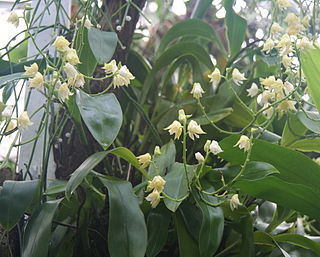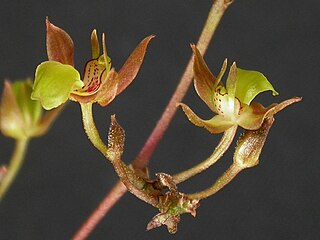
Cypripedioideae is a subfamily of orchids commonly known as lady's slipper orchids, lady slipper orchids or slipper orchids. Cypripedioideae includes the genera Cypripedium, Mexipedium, Paphiopedilum, Phragmipedium and Selenipedium. They are characterised by the slipper-shaped pouches of the flowers – the pouch traps insects so they are forced to climb up past the staminode, behind which they collect or deposit pollinia, thus fertilizing the flower. There are approximately 165 species in the subfamily.

Paphiopedilum, often called the Venus slipper, is a genus of the lady slipper orchid subfamily Cypripedioideae of the flowering plant family Orchidaceae. The genus comprises some 80 accepted taxa including several natural hybrids. The genus is native to Southeast Asia, the Indian Subcontinent, southern China, New Guinea and the Solomon and Bismarck Islands. The type species of this genus is Paphiopedilum insigne.

Phragmipedium is a genus of the Orchid family (Orchidaceae) and the only genus comprised in the tribe Phragmipedieae and subtribe Phragmipediinae. The name of the genus is derived from the Greek phragma, which means "division", and pedium, which means "slipper". It is abbreviated 'Phrag' in trade journals.

Mexipedium is a monotypic genus of the Orchid family Orchidaceae, subfamily Cypripedioideae, consisting of only one species, Mexipedium xerophyticum. It is also the single genus of tribe Mexipedieae and subtribe Mexipediinae.

Stanhopea is a genus of the orchid family (Orchidaceae) from Central and South America. The abbreviation used in horticultural trade is Stan. The genus is named for the 4th Earl of Stanhope (1781-1855), president of the Medico-Botanical Society of London (1829-1837). It comprises 55 species and 5 natural hybrids. These epiphytic, but occasionally terrestrial orchids can be found in damp forests from Mexico to Trinidad to NW Argentina. Their ovate pseudobulbs carry from the top one long, plicate, elliptic leaf.

Polystachya, abbreviated Pol in horticultural trade, and commonly known as yellowspike orchid, is a flowering plant genus in the orchid family (Orchidaceae). This rather distinctive genus was described by William Jackson Hooker in 1824 and is the type genus of the subtribe Polystachyinae. It contains about 100 species widespread across many of the tropical areas of the world.

Capanemia is a genus of flowering plants from the orchid family, Orchidaceae. It contains 9 recognized species, all from South America:
- Capanemia adelaidaePorto & Brade - Brazil
- Capanemia brachycion(Griseb.) Schltr. - Rio Grande do Sul, northern and eastern Argentina, Paraguay, Uruguay
- Capanemia carinataBarb.Rodr. - Minas Gerais, São Paulo
- Capanemia gehrtiiHoehne - Brazil
- Capanemia micromeraBarb.Rodr. - Bolivia, Brazil, Argentina, Paraguay, Uruguay
- Capanemia paranaensisSchltr. - Paraná
- Capanemia pygmaea(Kraenzl.) Schltr. - Brazil, probably extinct
- Capanemia superflua(Rchb.f.) Garay - Brazil, Argentina, Paraguay
- Capanemia theresaeBarb.Rodr. - Brazil

Centroglossa is a genus of flowering plants from the orchid family, Orchidaceae. It contains 5 accepted species, all endemic to Brazil:
- Centroglossa castellensisBrade - Espírito Santo
- Centroglossa greeniana(Rchb.f.) Cogn. in C.F.P.von Martius - Rio de Janeiro, São Paulo
- Centroglossa macrocerasBarb.Rodr.
- Centroglossa nunes-limaePorto & Brade - Minas Gerais, Espírito Santo
- Centroglossa tripollinica(Barb.Rodr.) Barb.Rodr.

Cyclopogon is a genus of flowering plants from the orchid family, Orchidaceae. It is a fairly large genus distributed widely over much of South America, the Galápagos, Central America, Mexico and the West Indies, with 2 species (C. elatus + C. cranichoides) in southern Florida.

Epistephium is a genus of flowering plants from the orchid family, Orchidaceae. It is native to South America, with a few species in Belize and Trinidad.
- Epistephium amabileSchltr.
- Epistephium amplexicaulePoepp. & Endl.
- Epistephium brevicristatumR.E.Schult.
- Epistephium duckeiHuber
- Epistephium elatumKunth in F.W.H.von Humboldt, A.J.A.Bonpland & C.S.Kunth
- Epistephium ellipticumR.O.Williams & Summerh. (Belize)
- Epistephium frederici-augustiRchb.f. & Warsz.
- Epistephium hernandiiGaray
- Epistephium lamprophyllumSchltr.
- Epistephium laxiflorumBarb.Rodr.
- Epistephium lobulosumGaray
- Epistephium lucidumCogn. in C.F.P.von Martius
- Epistephium matogrossenseHoehne
- Epistephium parviflorumLindl.
- Epistephium portellianumBarb.Rodr.
- Epistephium praestansHoehne
- Epistephium sclerophyllumLindl.
- Epistephium sessiliflorumLindl.
- Epistephium speciosumBarb.Rodr.
- Epistephium subrepensHoehne
- Epistephium williamsiiHook.f.

Eurystyles is a genus of flowering plants from the orchid family, Orchidaceae. It contains over 20 known species native to South America, Central America, the West Indies and Chiapas.
- Eurystyles actinosophila(Barb.Rodr.) Schltr.
- Eurystyles alticolaDod
- Eurystyles ananassocomus(Rchb.f.) Schltr.
- Eurystyles borealisA.H.Heller
- Eurystyles christensoniiD.E.Benn.
- Eurystyles cogniauxii(Kraenzl.) Schltr.
- Eurystyles cornu-bovisSzlach.
- Eurystyles cotyledonWawra
- Eurystyles cristata(Schltr.) Schltr.
- Eurystyles crocodilusSzlach.
- Eurystyles domingensisDod
- Eurystyles gardneri(Lindl.) Garay
- Eurystyles guentheriana(Kraenzl.) Garay
- Eurystyles hoehneiSzlach.
- Eurystyles lobataChiron & V.P.Castro
- Eurystyles lorenzii(Cogn.) Schltr.
- Eurystyles luisortizii
- Eurystyles ochyrana(Szlach., Mytnik & Rutk.) F.Barros & L.R.S.Guim.
- Eurystyles rutkowskianaSzlach.
- Eurystyles splendissimaSzlach.
- Eurystyles standleyiAmes

Koellensteinia is a genus of flowering plants from the orchid family, Orchidaceae. It is named by Heinrich Gustav Reichenbach for the Captain Carl Kellner von Koellenstein, an Austrian military officer and a botanical correspondent of Reichenbach.

Orleanesia is a genus of flowering plants from the orchid family, Orchidaceae. It contains 9 known species, all native to South America.
- Orleanesia amazonicaBarb.Rodr. - Brazil, Colombia, Venezuela, Bolivia, the Guianas
- Orleanesia cuneipetalaPabst - Brazil
- Orleanesia ecuadoranaDodson - Ecuador
- Orleanesia maculataGaray - Venezuela
- Orleanesia mineirosensisGaray - Brazil
- Orleanesia peruvianaC.Schweinf. - Peru
- Orleanesia pleurostachys(Linden & Rchb.f.) Garay & Dunst. - Colombia, Venezuela, Peru, Ecuador
- Orleanesia richteriPabst - Brazil
- Orleanesia yauaperyensisBarb.Rodr. - Brazil, Venezuela

Paradisanthus is a genus of flowering plants from the orchid family, Orchidaceae. It contains 4 known species, all endemic to Brazil.
- Paradisanthus bahiensisRchb.f.
- Paradisanthus micranthus(Barb.Rodr.) Schltr.
- Paradisanthus moseniiRchb.f.
- Paradisanthus neglectusSchltr.

Psilochilus is a genus of flowering plants from the orchid family, Orchidaceae. It is native to South America, Central America, Mexico and the West Indies.
- Psilochilus carinatusGaray - Colombia
- Psilochilus dusenianusKraenzl. ex Garay & Dunst. - Venezuela, Brazil
- Psilochilus macrophyllus(Lindl.) Ames - widespread from central Mexico and the West indies south to Peru
- Psilochilus maderoi(Schltr.) Schltr. - Colombia
- Psilochilus modestusBarb.Rodr. - Venezuela, Brazil
- Psilochilus mollisGaray - Ecuador
- Psilochilus physurifolius(Rchb.f.) Løjtnant - Venezuela, Guyana
- Psilochilus vallecaucanusKolan. & Szlach. - Colombia

Sarcoglottis is a genus of flowering plants from the orchid family, Orchidaceae. It is widespread across much of Latin America from Mexico to Argentina, with one species extending northward into Trinidad and the Windward Islands.

Skeptrostachys is a genus of flowering plants from the orchid family, Orchidaceae. It is native to eastern South America.
Veyretia is a genus of terrestrial orchids native to South America and Trinidad.
- Veyretia aphylla(Ridl.) Szlach. - Colombia, Venezuela, Guyana, Brazil
- Veyretia caudata(R.J.V.Alves) Mytnik - Minas Gerais
- Veyretia cogniauxiana(Barb.Rodr. ex Cogn.) Szlach. - Minas Gerais
- Veyretia hassleri(Cogn.) Szlach. - Brazil, Paraguay
- Veyretia neuroptera(Rchb.f. & Warm.) Szlach. - Colombia, Venezuela, Argentina, Brazil
- Veyretia rupicola(Garay) F.Barros - Brazil
- Veyretia sagittata(Rchb.f. & Warm.) Szlach. - French Guiana, Argentina, Brazil
- Veyretia simplex(Griseb.) Szlach. - Trinidad, Venezuela, Guyana, Brazil
- Veyretia sincorensis(Schltr.) Szlach. - Bahia
- Veyretia szlachetkoanaMytnik - Colombia, Venezuela
- Veyretia undulataSzlach. - Brazil

















